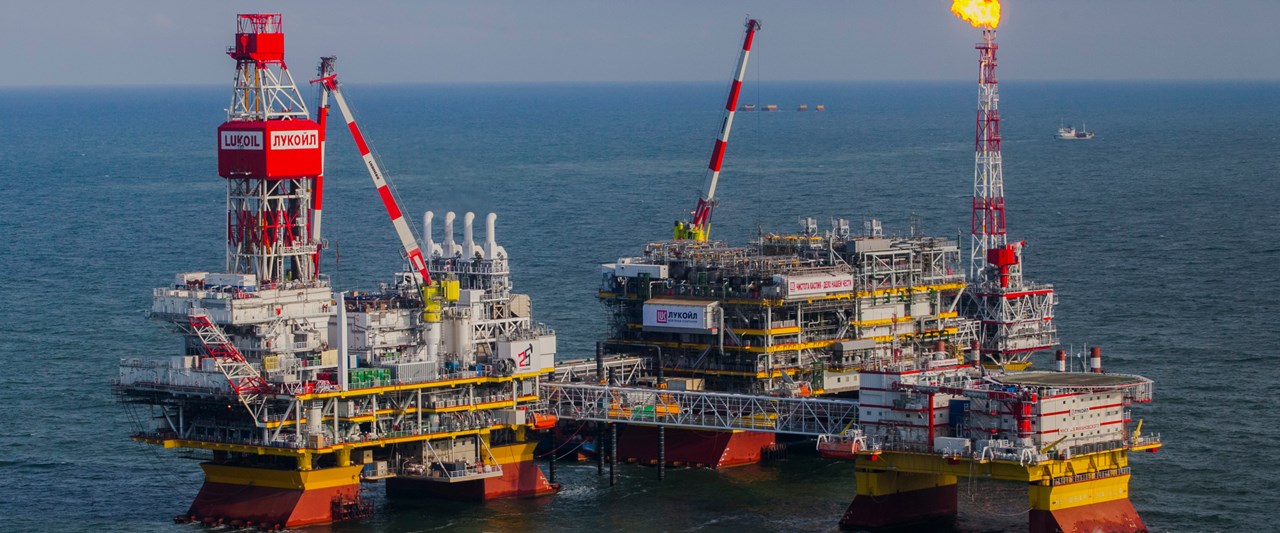Russian-Kazakh waters in the Caspian Sea are central to the company’s plans
Russian oil major Lukoil is pushing ahead with a raft of new projects in the Caspian Sea, as it looks to grow its offshore business and counter decline at its older fields in Western Siberia. The private operator revealed in early June that it had struck a preliminary deal to explore an area off the shore of Kazakhstan. The I-P-2 block lies in waters 300-400 metres deep and 130km from the port of Aktau. Lukoil will now engage in talks with KazMunayGas (KMG), Kazakhstan’s national oil company, to draw up an E&P contract and form a joint venture to develop the site. The Caspian Sea is integral to Lukoil’s growth plans. The company aims to ramp up production in the area by more than a quarter next year to 180,000boe/d—equivalent to almost 10pc of its overall oil and gas output. Lukoil has come a long way since entering the region in the mid-1990s, when it embarked on a drilling campaign that led to the discovery of six major oil and gas deposits in Russia’s offshore zone. The first of the fields, Korchagin, entered production in 2010 and was joined by the larger Filanovsky project six years later. Additional development is underway at both sites, and Lukoil plans to commission a third field known as Rakushechnoye in 2023. Lukoil’s current Caspian production is confined to Russian waters, although the company is looking to build up its Kazakh operations as well. In addition to I-P-2, it has committed to spending $270mn on exploring Kazakhstan’s Zhenis block under an E&P contract it finalised with KMG earlier this year. Zhenis, situated 80km from the shore in water 75-100 metres deep, has been assessed by Kazakh authorities to contain 4.5bn boe in potential resources. Lukoil also operates the Tsentralnoye and Khvalynskoye fields that straddle the Russian-Kazakh maritime border, although development is in limbo because of their remoteness from land and an outstanding legal dispute. The Kazakh government has handed out dozens of contracts for offshore development over the past two decades, although many of these projects have disappointed. Lukoil’s previous exploration venture at the Atash and Tyub-Karagan blocks ended in failure in 2011, when the company withdrew after drilling several dry wells.
Kazakh incentives
Lukoil’s CEO Vagit Alekperov explained the company’s renewed interest in offshore Kazakhstan early last year, citing a recent overhaul in the country’s taxation system. Offshore operators can now opt to pay an income-based tax in lieu of mineral extraction tax (MET), oil export duty and other levies. Critically, this tax does not apply when oil prices dip below $50/bl, offering operators some protection from market volatility. The Caspian’s operational challenges, such as logistical issues, difficult climate conditions and reservoir complexity, can make tax relief essential for a project’s success. Lukoil notably pays no export duty and a reduced rate of MET on its Russian fields in the area. Moscow-based ratings agency ACRA estimates the current breakeven cost of these projects, taking the tax incentives into account, at $35/bl. “Tax breaks are necessary due to the high initial capital costs and the relatively high cost of production,” an ACRA analyst told Petroleum Economist. “The IRR [internal rate of return] of Caspian projects is significantly higher than that of the mainland [Russian] projects, but this can be considered compensation for the higher risk.” According to Ashley Sherman, a Caspian research analyst at Wood Mackenzie, changes to Kazakhstan’s tax and subsoil legislation have “certainly revitalised international interest” in its offshore zone. Earlier this year Italy’s Eni—a shareholder in Kazakhstan’s flagship Karachaganak and Kashagan projects— also signed up to explore the offshore Abay block. While established players like Eni and Lukoil are keen to search new areas, Kazakhstan has struggled to bring new investors into the region. “These companies can look to other offshore exploration hot spots, elsewhere in the world, that offer lower costs, greater rig availability and a clearer path to quick development of any discovery,” says Sherman. https://www.petroleum-economist.com/articles/politics-economics/europe-eurasia/2019/lukoil-makes-inroads-offshore



